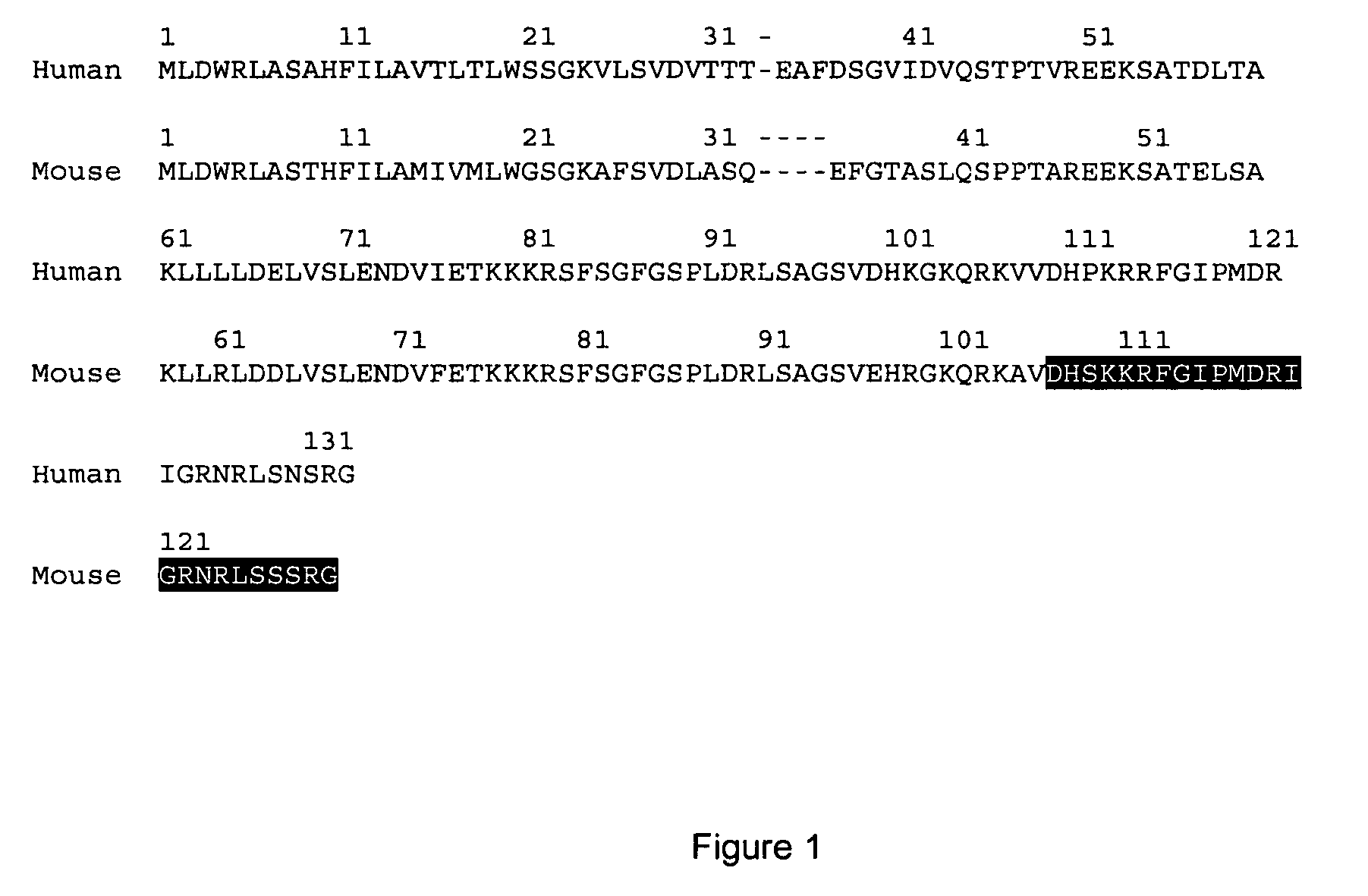Method of use of specific natriuretic peptide receptor c ligands, transgenic non-human mammals expressing specific natriuretic peptide receptor c antagonists and cells thereof
a technology of natriuretic peptides and receptors, which is applied in the direction of peptide sources, peptide/protein ingredients, drug compositions, etc., can solve the problems of limited c-terminal homology, volume depletion and lowering of blood pressure, and the role of npr-c-specific antagonists has not been demonstrated within, etc., to enhance bone growth, enhance np activity, and enhance cgmp levels
- Summary
- Abstract
- Description
- Claims
- Application Information
AI Technical Summary
Benefits of technology
Problems solved by technology
Method used
Image
Examples
example 1
Ostn Sequence Homology
[0103]Initial analysis of Ostn species conservation identified Ostn in humans, cows, mice, rats chicken and snakes (Thomas et al. 2003). Further analysis through genomic data mining has identified Ostn in amphibians (Ambystoma tigrinum tigrinum, Eastern tiger salamander) and fish (Danio rerio, Zebrafish) as well as chimpanzee, pig and dog. FIG. 2 shows the alignment between Ostn protein sequences from various vertebrate species with strong conservation of the C-terminal half of Ostn (e.g. human to amphibian=81% similarity). The putative cleavage sites are shaded and the two regions with homology to the NPs, NM1 and NM2, are boxed. Sequences were derived as previously described (Thomas et al. 2003), and from GenBank™ ESTs CF787546 (pig), CN052128 (salamander), AL918290 (zebrafish), and Ensembl™ genome release 21.3b.1, 21.1.1, and pre-release for zebrafish, chimpanzee, and dog respectively. FIG. 3 shows the alignment between Ostn polynucleotide sequences from the...
example 2
Non-Osseous Tissue Ostn Expression
[0107]Although initially identified as an osteoblast-specific gene, further analyses of non-osseous tissue expression demonstrated Ostn expression in other stromal-origin tissues. Northern blotting has demonstrated that Ostn was expressed at significant levels in both leg tendons and skeletal muscle of young adult rats (FIG. 5). Ostn levels appeared extremely high in tendons, with weaker expression in muscle. However direct comparisons are difficult to draw between tissues due to differing cellularity and homogeneity of cell populations.
example 3
Assessment of Ostn and Ostn Fragment Binding to Natriuretic Receptors
[0108]To analyze the potential binding of Ostn to natriuretic receptors, a fusion protein (PLAP-Ostn) (FIG. 6) was generated as described above. This fusion protein comprised an N-terminal secreted placental alkaline phosphatase (PLAP) moiety linked to mature mouse Ostn (residues 29-130) (SEQ ID NO: 62). Conditioned media containing PLAP-mOstn was used to assess Ostn binding on transiently transfected cells.
[0109]Expression vectors for the coding sequence of GC-A, GC-B and NPR-C were constructed, transfected into human embryonic kidney (HEK) 293 cells and the cells incubated with either 37 nM PLAP or the PLAP-Ostn fusion. The method of preparation of these vectors and transfection of these cells may be found above.
[0110]Identical very low non-specific binding of PLAP-Ostn to GC-A-, GC-B-, or GFP-transfected cells was observed. Only results for the GFP and GC-B binding are shown for clarity.
[0111]Saturable binding o...
PUM
| Property | Measurement | Unit |
|---|---|---|
| Tm | aaaaa | aaaaa |
| temperatures | aaaaa | aaaaa |
| thermal melting point | aaaaa | aaaaa |
Abstract
Description
Claims
Application Information
 Login to View More
Login to View More - R&D
- Intellectual Property
- Life Sciences
- Materials
- Tech Scout
- Unparalleled Data Quality
- Higher Quality Content
- 60% Fewer Hallucinations
Browse by: Latest US Patents, China's latest patents, Technical Efficacy Thesaurus, Application Domain, Technology Topic, Popular Technical Reports.
© 2025 PatSnap. All rights reserved.Legal|Privacy policy|Modern Slavery Act Transparency Statement|Sitemap|About US| Contact US: help@patsnap.com



